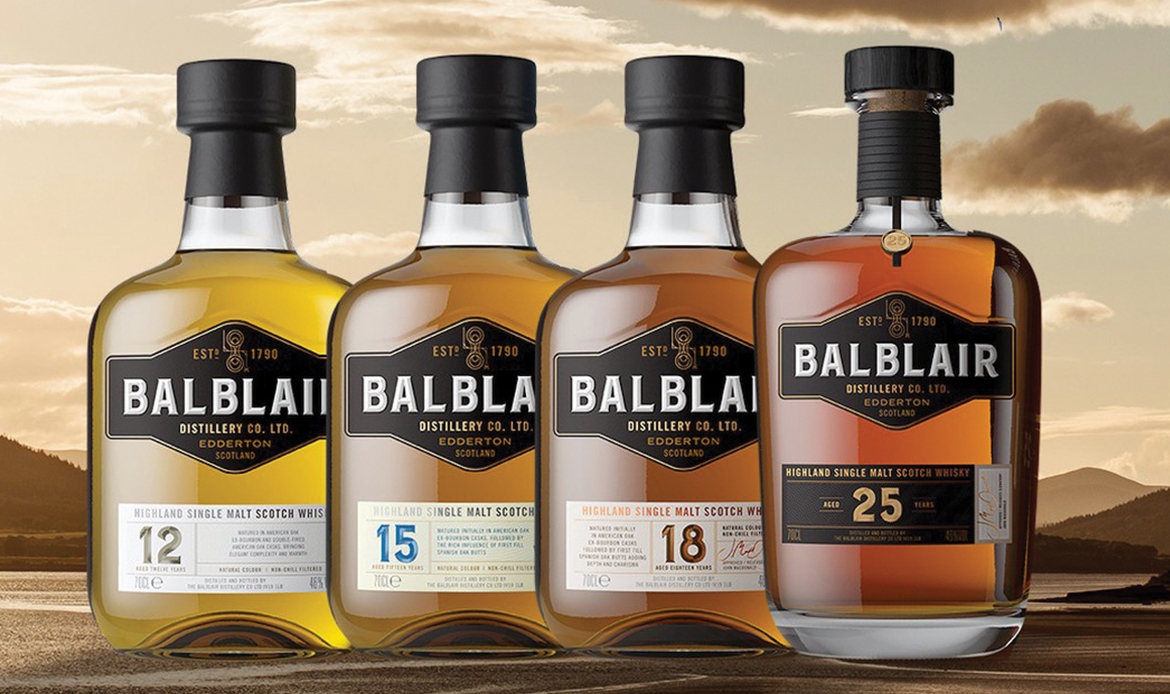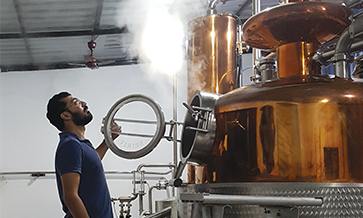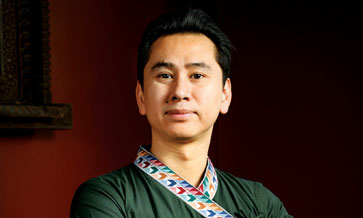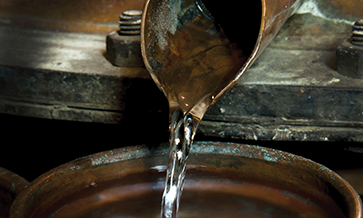Mark Williamson is Whisky Maker and Blender for Inver House Distilleries, Scotland. He works as a blender within the maturation and blending team, to uphold the highest quality of blended whisky and single malts. Mark is a B.Sc. (Hons.) brewing and distilling graduate from Heriot-Watt University, Edinburgh.
What brings you to India, Mark?
I am here to host and attend a series of events and share our portfolio of single malts – such as Balblair, Old Pulteney and Speyburn – with discerning whisky enthusiasts here. I have also been visiting some of the popular bars around Delhi. This is a great opportunity for me to find out more about the Indian market, its varied audiences and preferences, and local products, including some popular Indian single malts.
Balblair has been releasing its single malts as vintages so far. Can you tell me why?
Since 2007, Balblair has been releasing only vintage whiskies. Put simply, vintages represent the specific year in which the spirit was distilled and laid down in casks. So, for vintages, we only look for casks from one particular year.
If it says 2005 on the label, then we only use casks from that year. That way it gives you a picture of what was happening at Balblair at that moment in time.
You have shifted back to age statements from vintages. Could you explain that move?
We have released 32 vintage expressions since 2007. The move away from vintage to a core range of age statement whiskies was heavily researched over the past 2 years. We made this decision in order to bring greater consistency to our range and best showcase our distillery’s true character.
Our core range will continue to be bottled at 46% ABV. We will continue to bottle Balblair at its natural colour (no added caramel) and it will remain to be non-chill filtered. The character of all our new releases echoes that of previous Balblair expressions.
We will continue to take great pride in offering the world an exceptional collection of single malt Scotch whiskies. After all, we are still Balblair!
You didn’t want to let them both (vintages and age-statement) coexist?
The current core vintages are being replaced with four new-age statement whiskies (12, 15, 18 and 25-year-olds) with a global rollout from April 2019.
As a result of this move, the core range going forward will consist of aged expressions. However, we may consider limited vintage releases in the future to complement the core range.
You just use ex-bourbon casks and ex-sherry butts for your whiskies?
We’ve been quite a traditional company, and we use Spanish or American oak only. We are carrying out trials and experiments with other types of wood, so there may be new things coming out.
With American and Spanish oak casks, we can use first fill, second fill and third fill. Also, we use re-charred, or “double-fired” casks, whereby we remove the inside layer and rechar the casks. So, on the face of it, we have two types of casks, but actually we have up to four in each of those categories, each giving a different character to the whisky.
Is it true that a lot of the oak used in the sherry industry is actually from America?
Our Spanish oak comes from a Bodega in Spain, where they season it with sherry or Oloroso wine within the sherry triangle. So, it really is Spanish oak. We use butts that are around 500 litres. The staves on the casks are around 2 inches thick, compared to the American oak barrel, which is maybe an inch thick.
So, these are huge casks, a lot thicker, bigger and well-seasoned and specially made for us in Spain. We also ask them to season them for up to 3 years with the Oloroso wine. If we use them straightaway as fresh wood, then the Spanish oak has just far too much tannin, and we would end up with a really cloudy kind of unpleasant whisky that would be too woody in a year’s time.
So, the Sherry is decanted in Spain and they actually use it to make sherry vinegar. Otherwise, that sherry has too much wood extract in it to be of any good.
American oak is also used in the Bodega region in Spain’s Solera system, where they really don’t want any extract from it. They just want some oxidation from the temperature and a holding vessel for blending.
To transport the sherry from that cask to the UK earlier, they used Spanish oak butts. They have plenty of those and they didn’t really want them back. So, we kept them in the whisky industry, and that worked well for us!
Nowadays, sherry has to be bottled in Spain, and we don’t get those transportation casks in the UK. We have to go to the suppliers to buy it. So, if you like, it’s a different product to the American oak casks that are used day-to-day in the sherry industry.
You are double-charring the 12-YO as an example.
That’s right. Part of the make-up is the double-fired. This adds different characteristics to the liquid. A double-fired cask will add complexity without adding too much spiciness and vanilla. Using the first fill, second fill or third fill give different characteristics at different ages.
If you use a cask more than once, we find that it gives less in the way of vanilla, toffee or spicy aromas. But that doesn’t mean it’s not a good cask; it means you can mature for longer without being overwhelmed by the woody character and that is the subtlety we’re looking for.
Are you experimenting with different wood types for maturation, or for finishing, or for both?
For both. We prefer to use the term “further maturation” rather than “finishing”. Finishing can be anything from a day’s to a week’s process, just to give the whisky a different colour or a very slight change in flavour.
However, in the Balblair range, we would tend to focus on further maturation because each expression has been in the second cask for maturation for at least 18 months. So, when you read on the label ‘Matured in American and Spanish oak’, you know each one is going to contribute each of its bold flavours.
We want some big bold flavours coming from each of the cask types. For instance, we have started to use casks which previously held peated whisky for one of our Old Pulteney products. We finished this in around three to six months, to take on a very slight peaty character.
I noticed that even the water which you use for Balblair is peated.
That’s right. It may not add the same peat or smoky character, but brings a certain earthiness to the Balblair. Water is quite overlooked in some ways in terms of bringing flavour, but whenever we distil, we use 100% water to start with.
Then, when we ferment, this gives us about 9% alcohol. We distil twice and this takes us up to about 68% alcohol, but we have about 31% water remaining, which is still quite a big part of the whisky. So rather than the smoky, ashy aromas that we would associate with heavily peated malt, we get a more earthy or mineral mouthfeel from it.
Is the water naturally peaty?
That’s right; it’s a completely natural water and runs down the hill 7 miles from its source. And it picks up the peaty earthy flavours as it goes.
Pulteney and Balblair are both Highland malts. How would you compare or contrast them?
Number one is the water source. As I said, a little bit of peated character for Balblair comes from the water, otherwise it is quite pure. For Old Pulteney, we use loch water, which is very different. It’s not as purified as the Balblair water and it gives a little heaviness to the water.
Then, there are the stills at each distillery. Balblair has small squat stills, but they’re quite typical. We call them onion-shaped, but kind of flattened onion-shaped and this captures the fruity, estery character really well.
So, for the new make spirit, we’re looking for apricots, grapes, peaches, mangoes, these sort of tropical fruit flavours and a little bit of a leathery character as well, that comes from the water source. For Pulteney, the still shape is quite unusual, the wash still has a big boil ball which increases reflux and has a smuggler’s kettle-type shaped Lyme arm.
A still is a separator of flavour compounds. The lighter flavour compounds always go to the top, and at Balblair there is no exception. They go upwards and get carried over to the new make spirit.
At Pulteney, the lighter flavour compounds stay at the top and then react with the copper and reflux back down. We collect the slightly heavier flavours because the Lyme arm is about 18 inches lower. This makes Old Pulteney a richer, heavier, more full-bodied new-make spirit.
Pulteney is matured by the sea as well. We like to think that there’s a little salty tang to it because of that. I think that rather than the sweetness, it does give it a finish which has a kind of brininess to it.
You went to Heriot-Watt. What would your advice be to somebody who wanted to build a career as a distiller?
I was lucky enough to go to Heriot-Watt and it’s a great mix of chemistry, yeast biology, a little bit of engineering. I also do quite a lot of calculations because we have a lot of stock available: we have 6,20,000 casks at our maturation or blending site, and each distillery holds between 5,000 and 20,000 casks. So, there’s quite a lot of arithmetic involved on a day-to-day basis.
More importantly, what we want to do is to enable ourselves to have a drive and ability to create something creative. You have to be able to look at 100 casks and say, “Okay, these are all different. How can I use them? How can I make something interesting?”
I’ve taken a certain route and was lucky enough to study at Heriot-Watt, but there is no doubt that experience counts for a lot. There are courses; not only degree courses, but more practical courses that you can take later on – when you have that little bit of experience to help with some of the more difficult aspects.
You have the first Highland Whisky Festival coming up. Can you tell me about it?
In a way, it rivals the Speyside Whisky Festival, which has been running for a good number of years now. We have two Highland distilleries and they’re open as normal throughout the week. As part of the festival, there is a special day for each distillery when there are several tours throughout the day, ranging from an hour’s visit to having the whole evening at the distillery.
At Balblair, you can have dinner with John McDonald, the distillery manager, and watch a film, The Angel’s Share (directed by Ken Loach) that was filmed partly at Balblair. We have a showing in the actual warehouse where it was filmed.
Managers at both distilleries have around 30 years of experience in the industry, so a great wealth of knowledge to share. Lastly, we usually have a single cask bottling and we’ve selected a special cask in each case for the whisky festival special.
What’s your own desert island dram?
The Balblair 18-year-old is fantastic to me! It’s a nice balance between the American oak and the Spanish. Everyone has their balance point and the 18-year-old for me is spot-on.














